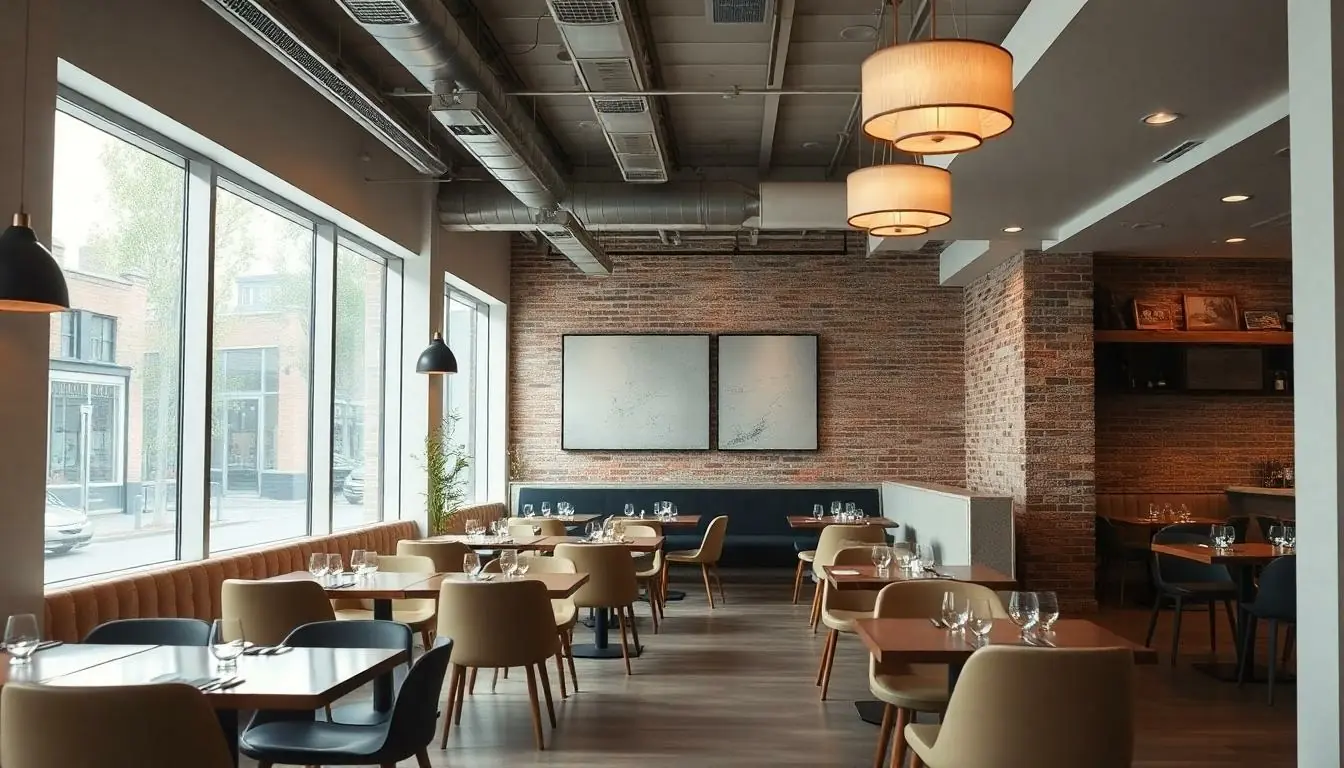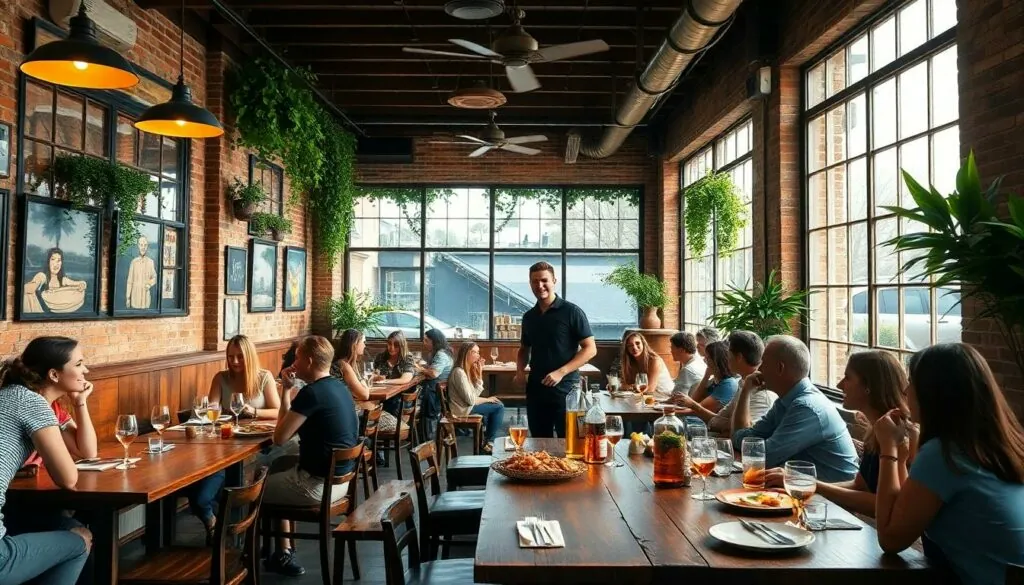In the bustling world of dining, a restaurant’s interior design can make or break the experience. It’s not just about serving delicious food; it’s about creating an atmosphere that lures customers in and keeps them coming back for more. With trends evolving faster than a chef can flip a pancake, staying ahead in the design game is crucial for any eatery looking to stand out.
From cozy nooks that invite intimate conversations to vibrant spaces that spark joy, the right design can transform a simple meal into a memorable occasion. As we dive into the latest interior design trends for restaurants, get ready to discover how to spice up your space and keep patrons raving about not just the food, but the ambiance too. After all, who wouldn’t want to dine in a place that feels like a feast for the eyes?
Table of Contents
ToggleOverview of Interior Design Trends for Restaurants
Current trends in restaurant interior design prioritize ambiance and comfort. Designers focus on creating spaces that enhance customer experiences while reflecting a restaurant’s brand identity. Natural materials, such as wood and stone, gain popularity for their warm and inviting qualities. Sustainability influences many restaurant interiors, with eco-friendly materials and practices becoming standard.
Color schemes often lean towards earthy tones, combining greens, browns, and soft neutrals. These colors create a soothing environment, appealing to diners seeking a relaxing atmosphere. Lighting plays a crucial role, with ambient and task lighting being strategically used to create mood and draw attention to food presentations.
Open floor plans continue to trend, promoting flexibility and interaction among guests. This style encourages a communal dining experience and caters to larger groups. Unique furniture designs, incorporating bold shapes and textures, also stand out, ensuring that seating arrangements enhance the overall aesthetic.
Art installations increasingly become focal points in restaurant design. Local artists often contribute, making art a significant part of the dining experience. This connection to the community strengthens patrons’ ties to the establishment.
Technology integrates into design, with features like contactless menus and smart lighting systems providing convenience. Restaurants looking to embrace modernity should consider incorporating these elements into their interiors. Overall, staying informed about these trends helps eateries create not just spaces but experiences that resonate with diners.
Popular Design Styles

Current restaurant design trends showcase several popular styles, each offering unique qualities that enhance overall ambiance and meet customer desires.
Modern Minimalism
Modern minimalism emphasizes simplicity and functionality. Sleek lines, uncluttered spaces, and a neutral color palette create a calm atmosphere. Furniture often features straight geometries and natural materials, ensuring a clean aesthetic. Open spaces allow for easy movement and interaction. Decorative elements remain minimal, focusing attention on food and service. This style suits restaurants targeting a contemporary clientele, aligning with trends that prioritize cleanliness and efficiency.
Rustic Charm
Rustic charm captures the warmth of nature and traditional craftsmanship. Natural wood, stone accents, and vintage furnishings define this style. Earthy tones enhance the cozy atmosphere, making diners feel at home. Exposed beams and handmade décor elements create an inviting environment. Outdoor-themed elements connect patrons to their surroundings, fostering a sense of authenticity. This design choice appeals to restaurants that celebrate local culture and community ties.
Industrial Aesthetics
Industrial aesthetics draw inspiration from urban environments. Exposed brick, metal fixtures, and raw materials define this rugged style. High ceilings and large windows maximize natural light, creating an airy dining space. Vintage lighting fixtures add character while maintaining functionality. Open floor plans encourage a communal feel, attracting patrons seeking a relaxed atmosphere. This trend complements establishments favoring a bold, modern identity, resonating with dynamic dining experiences.
Color Palettes in Restaurant Design
Color palettes play a crucial role in creating an inviting atmosphere in restaurants. Choices in color can influence a diner’s mood and overall dining experience.
Bold vs. Subtle Colors
Bold colors energize spaces, drawing attention to key areas like entrances or feature walls. Bright reds and vibrant yellows stimulate appetite and conversations, making them popular in casual dining settings. Subtle colors, on the other hand, promote relaxation, often found in fine dining establishments. Soft blues and muted greens create calmness, contributing to an intimate dining experience. Striking a balance between bold and subtle options invites diners to linger longer, heightening their engagement with the environment.
The Role of Neutrals
Neutral colors provide a versatile backdrop, easily complementing various design elements. Shades like beige, gray, and white allow furniture and decor to stand out without overwhelming the senses. Many restaurants combine neutral palettes with accent colors to create visual interest while maintaining a cohesive look. Incorporating warm neutrals fosters a welcoming ambiance that encourages social interactions among guests. Overall, neutrals serve as a foundation for layering textures and materials, enhancing a restaurant’s overall aesthetic appeal.
Furniture and Layout Innovations
Restaurants increasingly adopt innovative furniture and layout designs to enhance guest experiences. These trends emphasize comfort, functionality, and aesthetic appeal to create inviting spaces.
Versatile Seating Solutions
Flexible seating options play a significant role in modern restaurant design. Banquettes and communal tables accommodate varied group sizes. Individual chairs allow for easy rearrangement, promoting adaptability during peak hours. Foldable or stackable furniture offers simplicity in storage and versatility across different dining setups. Additionally, incorporating unique seating styles, such as lounge areas or bar seating, encourages social interactions while enhancing the dining experience.
Optimizing Space for Flow
Creating a smooth flow within restaurant layouts enhances visitor experiences significantly. Open layouts encourage movement and interaction among guests. Strategic placement of pathways allows for easy navigation, reducing congestion. Designers utilize zoning techniques to define areas, such as dining, waiting, and bar sections, catering to diverse customer needs. Multi-functional spaces also gain popularity, serving various purposes throughout the day, thus maximizing efficiency. Effective space utilization helps maintain a welcoming atmosphere, keeping diners engaged and satisfied.
Incorporating Technology in Design
Integrating technology into restaurant interior design enhances the dining experience and creates efficiencies. Current trends show that smart solutions provide added convenience and improved ambiance.
Smart Lighting Solutions
Innovative lighting technologies offer flexibility and control. Dimmable LED fixtures allow restaurants to adjust brightness based on time of day or mood. Programmable lighting systems create dynamic atmospheres, matching light intensity and colors with specific dining experiences. These solutions can also incorporate motion sensors to conserve energy during off-peak hours, promoting sustainability. Restaurants utilizing such systems report improved customer satisfaction and engagement.
Audio-Visual Integration
Audio-visual elements play a crucial role in modern dining. Strategically placed screens can display menus, promotions, or ambient visuals that align with a restaurant’s theme. Integrated sound systems deliver high-quality audio, enhancing the atmosphere without overwhelming conversations. For instance, background music can be tailored to match peak dining hours or special events, encouraging guests to linger. Seamless technology integration fosters a memorable experience while reflecting the establishment’s brand identity.
Sustainability in Restaurant Interior Design
Sustainability increasingly defines restaurant interior design. Embracing eco-friendly practices not only attracts environmentally conscious customers but also creates a unique dining environment.
Eco-Friendly Materials
Natural materials play a crucial role in sustainable restaurant designs. Bamboo, reclaimed wood, and recycled metal find common usage, reducing the carbon footprint. Designers often choose low-VOC paints to improve indoor air quality. These materials not only contribute to durability but also enhance aesthetic appeal. Sustainable fabrics for upholstery, such as organic cotton and hemp, add comfort while demonstrating an establishment’s commitment to the environment.
Biophilic Design Elements
Biophilic design integrates nature into restaurant interiors, fostering a connection between indoor spaces and the natural world. Green walls or vertical gardens significantly enhance air quality and customer mood. Incorporating large windows allows for ample natural light, reducing the need for artificial lighting. Water features, such as indoor fountains, create serene atmospheres that promote relaxation. Plants and greenery throughout the space not only beautify but also improve overall wellbeing for guests and staff alike.
Adapting to the latest interior design trends is essential for restaurants aiming to create memorable dining experiences. By focusing on ambiance comfort and sustainability, eateries can enhance their appeal and foster lasting connections with customers.
Incorporating natural materials earthy color palettes and innovative layouts not only reflects a restaurant’s brand but also promotes a welcoming atmosphere. Embracing technology and unique design elements can further elevate the dining experience.
Ultimately staying ahead of these trends allows restaurants to stand out in a competitive market ensuring patrons return for both the food and the inviting environment.





